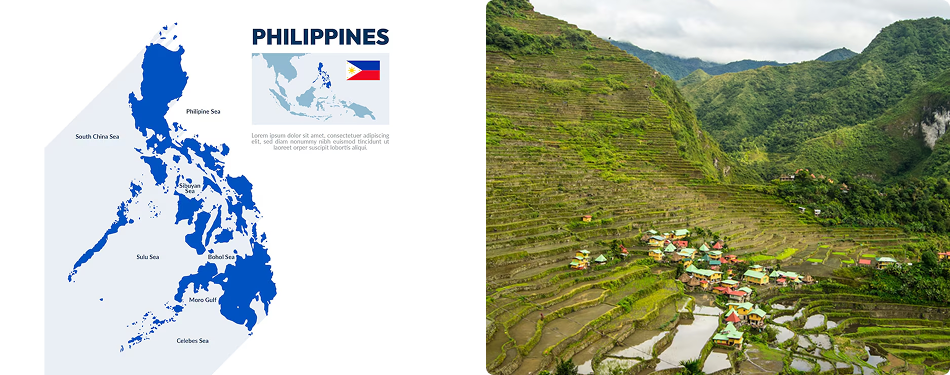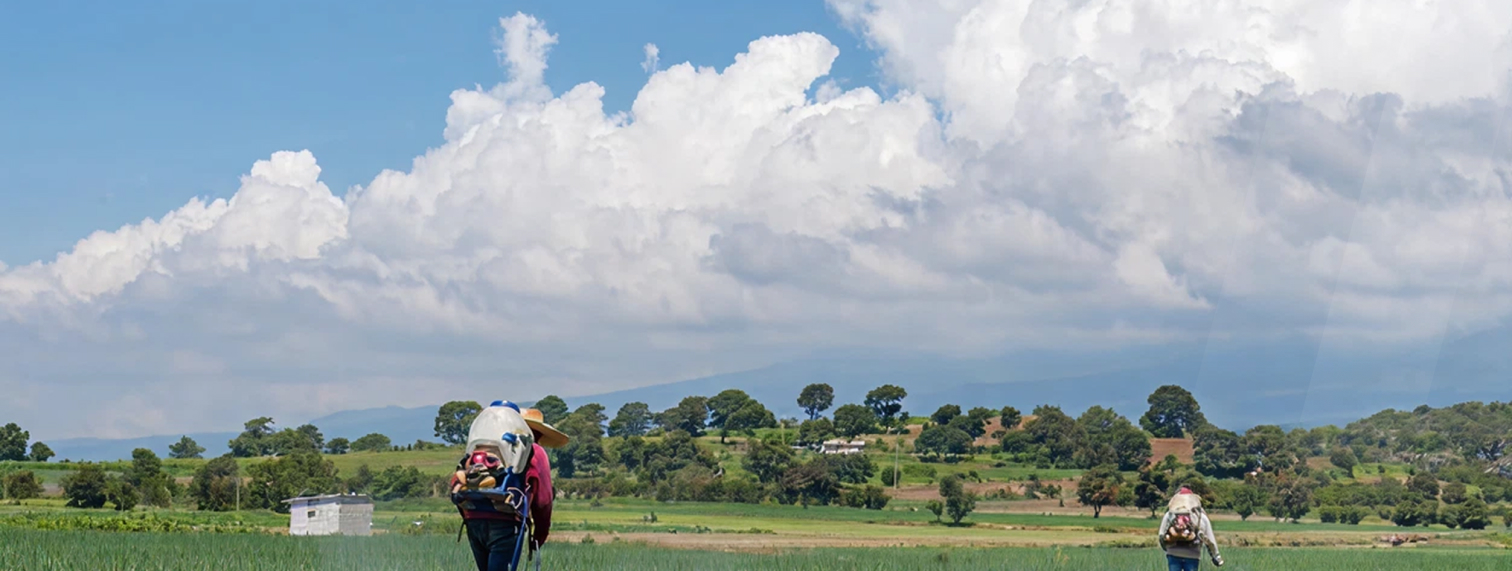Please Signup
I accept all terms and conditions
Philippines
Agriculture plays a crucial role in the Philippine economy, providing livelihoods for millions while facing challenges such as food security, climate vulnerability, and production inefficiencies.

Geographic Profile
Demographic Profile
Economic Profile
Main Products
Current Concerns

Total agricultural land area World Bank, 2021

Contribution of agriculture to total GDP

Percentage of the labor force in agriculture
The Philippines is an archipelago located in Southeast Asia, situated in the western Pacific Ocean. It consists of 7,641 islands divided into three main geographical regions: Luzon, Visayas, and Mindanao. The country lies between Taiwan to the north, Vietnam to the west, and Indonesia to the south. The capital city, Manila, is located on Luzon Island. The strategic location of the Philippines makes it a crossroads for various trade routes and cultural influences in the Asia-Pacific region.
The terrain of the Philippines is highly varied, dominated by mountainous regions with several active volcanoes, fertile coastal plains, and rolling hills. The highest peak in the country is Mount Apo, which stands at 2,954 meters above sea level. Major river systems such as the Cagayan River in Luzon and the Mindanao River on Mindanao Island support agriculture and freshwater resources. The country’s soils range from volcanic ash soils found in mountainous areas to alluvial soils in the river basins and coastal plains. These soil types are crucial for different types of crop cultivation.

The Philippines experiences a tropical climate characterized by high temperatures, high humidity, and abundant rainfall throughout the year. The climate is classified into three main types: tropical rainforest, tropical monsoon, and tropical savanna, varying across the islands. The average annual temperature ranges from 25°C to 32°C, with only slight variation throughout the year. Rainfall is significant, averaging about 2,000 millimeters annually, with a distinct wet season from June to November and a dry season from December to May. The eastern parts of the country tend to receive heavier rainfall due to the prevailing Pacific trade winds, while the western regions are relatively drier. The Philippines is also highly prone to natural hazards such as typhoons, floods, and occasional droughts, which greatly impact agricultural productivity.

The agricultural landscape of the Philippines is divided into distinct agro-ecological zones that reflect the country’s diverse environmental conditions. Lowland plains with fertile soils are primarily used for cultivating staple crops such as rice, corn, and sugarcane. Upland and mountainous areas support the cultivation of root crops like sweet potatoes, coffee, and various vegetables suited to cooler climates. Coastal zones are significant for coconut production and fisheries. Overall, about 44 million hectares of land are classified as agricultural, representing nearly half of the country’s total land area.
In the most recent census update by the Philippine Statistics Authority (PSA) in 2020, it was found that about 26% or one in every four of the population in the Philippines reported Tagalog as their ethnicity. This makes it one of the major ethnicities in the country along with Bisaya, Ilocano, Cebuano, Ilonggo, Bikol, Waray, Kapampangan, and Maguindanao and Pangasinan. About 7.6% of the population were classified as Indigenous Peoples (IPs) by the National Commission on Indigenous People (NCIP), 5.0% are Muslims identified by the National Commission on Muslim Filipinos (NCMF), 1.5% are IPs and Muslims identified by both NCIP and NCMF, and 0.2% are foreign ethnicities.
The Philippines is the only Christian nation in Asia, making Christianity the national religion of the country. From the 2020 Census of Population and Housing of PSA, it was revealed that Roman Catholics account for 78.8% of the household population in the country, followed by 6.4% of the population that is affiliated with Islam, and 2.6% of the population affiliated with Iglesia ni Cristo.
In 2022, the Philippines had a total population of about 115,559,009, making it the second most populated country in Southeast Asia next to Indonesia. Almost half or about 48% of the population in the same year are in urban areas, [23] while the remaining 52% are in rural areas. Generally, it can be inferred from the World Bank data on the annual population growth rate of the Philippines that the population in the country has been slowly declining. As a matter of fact, its population growth rate in 2022 was only at 1.5%, which was the lowest annual percentage growth since the 1947. Some of the underlying causes affecting this that have been analyzed by experts include women’s preference for planned pregnancies, issues of domestic violence, lack of access to family planning and health services, and economic and financial aspects.
In 2020, the COVID-19 pandemic affected the global economy, including the Philippines, which was manifested in the decrease in the earned GDP of the country. However, the Philippine economy rebounded and grew 7.6% in 2022, making it to the world’s top five fastest-growing large emerging markets that year. In 2022, the Philippines earned US$ 404.35 Billion that is equal to US$ 3,499.107 per capita. Upon ranking all countries according to its GDP, the Philippines ranked 40 and is one of the major economies by gross domestic product in 2022.
In the same year, the agriculture sector of the Philippines accounted for only about 9.5% of the total GDP, making it the lowest contributor to the country’s economy. About 46.6% of this share are from agricultural crops with 17% from rice, and 14.2% are from livestock.
n 2022, the country’s total labor force reached 47,871,825, and only about 5.4% of this population are unemployed according to the Philippine Statistics Authority (PSA). The services sector accounts for most of the employment in the Philippines which was estimated by the PSA to be at around 58.8% of the total in May 2024. This was followed by the agricultural sector and the industry sector, which had 24.2% and 16.9% of the total labor force, respectively.
Agriculture Labor Force
In 2022, the total employment in the agriculture sector of the Philippines was estimated by the ILO to be 24% of the total labor force. Trend from the data presented by the World Bank shows that this has been declining through the years. Some of the several reasons for this decline are the aging farming population, land conversion, and displacement of farm labor due to mechanization.
The country’s average headline inflation in 2022 reached 5.8% which manifested a 3.9% increase from the previous year. The inflationary pressure, as reported by the Senate Economic Planning Office of the Senate of the Philippines, mainly came from the continuous rising of global oil prices, exacerbated by the simultaneous rise in commodity prices, and depreciation of the Philippine peso. This may particularly affect the low-income households who are more vulnerable due to lack of accessibility to affordable commodities.
Sugarcane has always been the country’s top agricultural commodities produced in terms of production quantity, and this is followed by rice and coconut. In 2022, the Philippines were able to produce 23,455,403.5 tons of sugarcane. It was in 2017 that the country was able to produce the highest production quantity of sugarcane at 29,286,893.18 tons. [Data from FAOstat]
Like in other Southeast Asian countries, the Philippines is also rich with various natural resources which include mining products that play an important role in the economic development of the country, particularly golds, silver, iron ore, and oil. About 11% of the global production of nickel comes from the Philippines in 2022, making it the second top producer of nickel in the world next to Indonesia.
Aside from these mineral natural resources, the Philippines is also gifted with various tourist spots of natural resources. An example of this would be the almost perfect cone-shaped Mayon volcano, and the Chocolate Hills which has been declared as one of the National Geologic Monument in the country of the UNESCO World Heritage Center in 1988.
In 2022, the Philippines had a total trade amounting to US$ 216,198.66 Million, and it had a trade deficit amounting to US$ 58,243.56 million according to the Summary of External Trade performance in the Philippines by PSA. This manifested a 38% year-on-year growth from the previous year. The country was also in deficit in terms of agricultural trade, which was at US$ 7,544,964,000. [Data from FAOstat]
Imports
The total imported goods of the Philippines in 2022 amounted to US$ 137.22 billion. This was a 17.4% increase from the previous year due to the increase in values of the 10 major commodity groups that the country imported. The most imported goods in 2022 were electronic products, which accounted for 23.9% of the country’s total imports. The country’s top import partner was China which accounted for about 28.22% of the total, followed by Indonesia and Japan.
In the same year, the Philippines’ total import of agricultural commodities amounted to US$ 13,373,535,000 with wheat being the top imported agricultural commodity which had a total import value of US$ 1,584,090,000. This commodity was also the top import in terms of quantity. [Data from FAOstat]
Exports
From PSA’s report on exports, the country manifested a negative growth in the sales of exports in 2022. The Electronic products commodity group remained to have the highest export sales value in the same year and account for more than half of the total exports. The country’s top exporting partner in 2022 was the USA which accounted for 12.47% of the country’s total export, followed by Japan and China.
In the same year, the country’s total export of agricultural commodities amounted to US$ 5,828,571,000 Million, with Coconut Oil having the highest export value of US$ 2,099,955,000. This was followed by bananas that earned a total export value of US$ 1,095,512,000 from the 2,301,595.61 tons that the country was able to produce. [Data from FAOstat]
The industry sector of the Philippines is one of the major economic sectors in the country that significantly contributes to the economy of the country. As a matter of fact, in 2022, the Industry sector along with the Services sector posted positive growths, thus contributing to the gross domestic product. With the industrialization strategy of the government that aims to empower local industries and increase the country’s global competitiveness, truly efficient efforts and facilitations are to be served to secure this goal. The following industries are some of the major industries in the country that are recognized as key drivers of economic growth in the country:
According to the Board of Investments Philippine (2017), the Philippine manufacturing industry remains to be the most important sector for long-term productive employment, value-added generation, and innovation. As a matter of fact, this fills up more than have of the country’s industrial sector and accounts for almost a quarter of the country’s GDP.
The Philippines is recognized as one of the richest in the world in terms of natural resources, including minerals. Despite contributing a little less than the contribution of other industries to the country’s total GDP, the mining and quarrying industry of the Philippines still plays a crucial role in the economy as it employs hundreds of thousands of people which also serves as a support to other industries in the country.
Like any other industries in the country, the construction industry continues to be one of the predominant drivers of the Philippines’ economic progress. It plays a crucial role in infrastructure development which creates jobs, thus harnessing the continuous economic growth of the country.
In the most recent update by the Food and Agriculture Organization on the State of Food Security and Nutrition in World 2023 report on the Philippines, it was found that almost half of the population or about 44.7% of the population in the Philippines were moderately or severely food insecure. Some of the factors identified that exacerbated food insecurity in the country was the vulnerability of the country to natural disasters such as earthquakes and typhoons. Food security has always been an essential objective in the Philippine agricultural system, considering the relationship of the agriculture sector with food and nutrition. It is, therefore, crucial to determine the food and nutrition status of the country so that appropriate solutions to these issues and challenges can be put into place. The following nutrition indicators were obtained from various sources:
Undernourishment
In 2021, the prevalence of undernourishment in the country was 5% of the population according to data obtained from the World Bank. Trend shows that this has been slowly declining since 2001 with some increases between 2008 to 2011. Nevertheless, it can be assumed from this data that the efforts to reduce undernourishment in the county is in good progress.
Stunting
Data from FAOstat database shows that a modeled estimate of 28.8% of children under age 5 are stunted in the Philippines in 2022, and this had been slowly declining through the years.
Overnourishment
A modeled estimate of about 4.6% of children under age 5 are overweight in the Philippines in 2022 according to the data obtained from the FAOstat database. However, this had been slowly increasing through the years. Thus, it is crucial to provide extensive efforts and solutions to this problem of overnutrition in the country.
Truly, the Philippines have issues in the local production of the agricultural sector, as manifested in the agricultural trade deficit of the country in 2022. This implies that with the insufficiency in production and high reliance on importation, it is vital to distinctively understand the grievance of the issues and challenges in the sector to provide solutions with appropriate actions. The following issues are identified among many issues in the sector that affects the production and ultimately the food and nutrition in the Philippines:
Food-population Imbalance.
Though the population in the Philippines is slowly declining through the years, the rise in population is still an ingredient to the food-population imbalance in the country alongside the slow growth of the agriculture sector. This means that there is not enough food produced by the sector to meet the food and dietary requirements of the people in the Philippines; hence, it is crucial for the government to focus on boosting the local food production in the country to also mitigate the reliance on importation of agricultural commodities.
Lack of Post-harvest Facilities
The lack of facilities in the country for post-harvest storage and preservation of agricultural commodities leads to post-harvest losses. Farmers are forced to sell their produce at a lower price to avoid stocking it up that could lead to reduced quality of the commodity and eventually spoilage, thus further resulting in significant income losses for the farmers.
Lack of access to formal credit services.
Several farmers in the Philippines are small holders which do not have sufficient capital to purchase production inputs. Moreover, farmers lack access to formal credit services due to many barriers in their accessibility such as distance in terms of physical access, high transaction costs, and complexity of the process, forcing them to rely on informal credit with high charges.
Get the latest policy insights, research highlights, and knowledge resources from across Southeast Asia delivered straight to your inbox.
